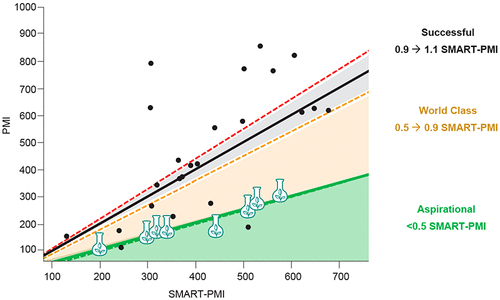当前位置:
X-MOL 学术
›
Org. Process Res. Dev.
›
论文详情
Our official English website, www.x-mol.net, welcomes your
feedback! (Note: you will need to create a separate account there.)
Driving Aspirational Process Mass Intensity Using Simple Structure-Based Prediction
Organic Process Research & Development ( IF 3.1 ) Pub Date : 2022-04-18 , DOI: 10.1021/acs.oprd.1c00477 Edward C. Sherer 1 , Ansuman Bagchi 2 , Birgit Kosjek 1 , Kevin M. Maloney 1 , Zhengwei Peng 3 , Sandra A. Robaire 4 , Robert P. Sheridan 3 , Essam Metwally 5 , Louis-Charles Campeau 1
Organic Process Research & Development ( IF 3.1 ) Pub Date : 2022-04-18 , DOI: 10.1021/acs.oprd.1c00477 Edward C. Sherer 1 , Ansuman Bagchi 2 , Birgit Kosjek 1 , Kevin M. Maloney 1 , Zhengwei Peng 3 , Sandra A. Robaire 4 , Robert P. Sheridan 3 , Essam Metwally 5 , Louis-Charles Campeau 1
Affiliation

|
An important metric for gauging the impact that a synthetic route has on chemical resources, cost, and sustainability is process mass intensity (PMI). Calculating the overall PMI or step-PMI for a given synthesis from a process description is more and more common across the pharmaceutical industry, especially in process chemistry departments. As with other pharmaceutical companies, our company has established a strong track record of delivering on our Corporate Sustainability goals, being recognized with eight EPA Green Chemistry Challenge Awards in the last 15 years, and we show how these routes help define aspirational PMI targets. While green chemistry principles help in optimizing PMI and developing more sustainable processes, a key challenge for the field is defining what a “good” PMI for a molecule looks like given its structure alone. An existing tool that chemists have at their disposal to predict PMI requires the synthetic route be provided or proposed (e.g., via retrosynthetic analysis) which then enables practitioners to compare predicted PMIs between routes. We have developed SMART-PMI (in-Silico MSD Aspirational Research Tool) to complement existing tools by predicting PMI from molecular structure alone. Using only a 2D chemical structure, we can generate a predicted SMART-PMI from a measure of molecular complexity and molecular weight. We show how these predictions correlate with historical PMI data from our company’s clinical and commercial portfolio of processes. From this SMART-PMI prediction, we have established target ranges which we termed “Successful”, “World Class”, and “Aspirational” PMI. The goal of this range is to set the floor for what is a “good” PMI for a given molecule and provide ambitious targets to drive innovative green chemistry. Using this model, chemists can develop synthetic strategies that make the biggest impact on PMI. As innovation in chemistry and processes leads to better and better PMIs, in turn, this data can drive ever more aggressive targets for the model. The potential of SMART-PMI, in combination with other existing PMI tools, to set industry-wide aspirational PMI targets is discussed.
中文翻译:

使用基于简单结构的预测驱动理想过程质量强度
衡量合成路线对化学资源、成本和可持续性的影响的一个重要指标是工艺质量强度 (PMI)。从工艺描述计算给定合成的整体 PMI 或 step-PMI 在制药行业越来越普遍,尤其是在工艺化学部门。与其他制药公司一样,我们公司在实现企业可持续发展目标方面建立了良好的记录,在过去 15 年中获得了八项 EPA 绿色化学挑战奖,我们展示了这些途径如何帮助确定理想的 PMI 目标。虽然绿色化学原理有助于优化 PMI 和开发更可持续的工艺,但该领域面临的一个关键挑战是,仅考虑其结构,定义分子的“良好”PMI 是什么样子的。化学家用来预测 PMI 的现有工具需要提供或提议合成路线(例如,通过逆合成分析),然后使从业人员能够比较路线之间的预测 PMI。我们开发了 SMART-PMI(in-Silico MSD 理想研究工具),通过仅从分子结构预测 PMI 来补充现有工具。仅使用 2D 化学结构,我们就可以通过测量分子复杂性和分子量来生成预测的 SMART-PMI。我们展示了这些预测如何与我们公司临床和商业流程组合中的历史 PMI 数据相关联。根据这个 SMART-PMI 预测,我们已经建立了我们称之为“成功”、“世界级”和“有抱负”的 PMI 的目标范围。该范围的目标是为特定分子的“良好”PMI 奠定基础,并提供雄心勃勃的目标来推动创新的绿色化学。使用该模型,化学家可以制定对 PMI 产生最大影响的合成策略。随着化学和工艺的创新带来越来越好的 PMI,反过来,这些数据可以为模型推动更积极的目标。讨论了 SMART-PMI 与其他现有 PMI 工具相结合的潜力,以设定全行业的理想 PMI 目标。
更新日期:2022-04-18
中文翻译:

使用基于简单结构的预测驱动理想过程质量强度
衡量合成路线对化学资源、成本和可持续性的影响的一个重要指标是工艺质量强度 (PMI)。从工艺描述计算给定合成的整体 PMI 或 step-PMI 在制药行业越来越普遍,尤其是在工艺化学部门。与其他制药公司一样,我们公司在实现企业可持续发展目标方面建立了良好的记录,在过去 15 年中获得了八项 EPA 绿色化学挑战奖,我们展示了这些途径如何帮助确定理想的 PMI 目标。虽然绿色化学原理有助于优化 PMI 和开发更可持续的工艺,但该领域面临的一个关键挑战是,仅考虑其结构,定义分子的“良好”PMI 是什么样子的。化学家用来预测 PMI 的现有工具需要提供或提议合成路线(例如,通过逆合成分析),然后使从业人员能够比较路线之间的预测 PMI。我们开发了 SMART-PMI(in-Silico MSD 理想研究工具),通过仅从分子结构预测 PMI 来补充现有工具。仅使用 2D 化学结构,我们就可以通过测量分子复杂性和分子量来生成预测的 SMART-PMI。我们展示了这些预测如何与我们公司临床和商业流程组合中的历史 PMI 数据相关联。根据这个 SMART-PMI 预测,我们已经建立了我们称之为“成功”、“世界级”和“有抱负”的 PMI 的目标范围。该范围的目标是为特定分子的“良好”PMI 奠定基础,并提供雄心勃勃的目标来推动创新的绿色化学。使用该模型,化学家可以制定对 PMI 产生最大影响的合成策略。随着化学和工艺的创新带来越来越好的 PMI,反过来,这些数据可以为模型推动更积极的目标。讨论了 SMART-PMI 与其他现有 PMI 工具相结合的潜力,以设定全行业的理想 PMI 目标。











































 京公网安备 11010802027423号
京公网安备 11010802027423号